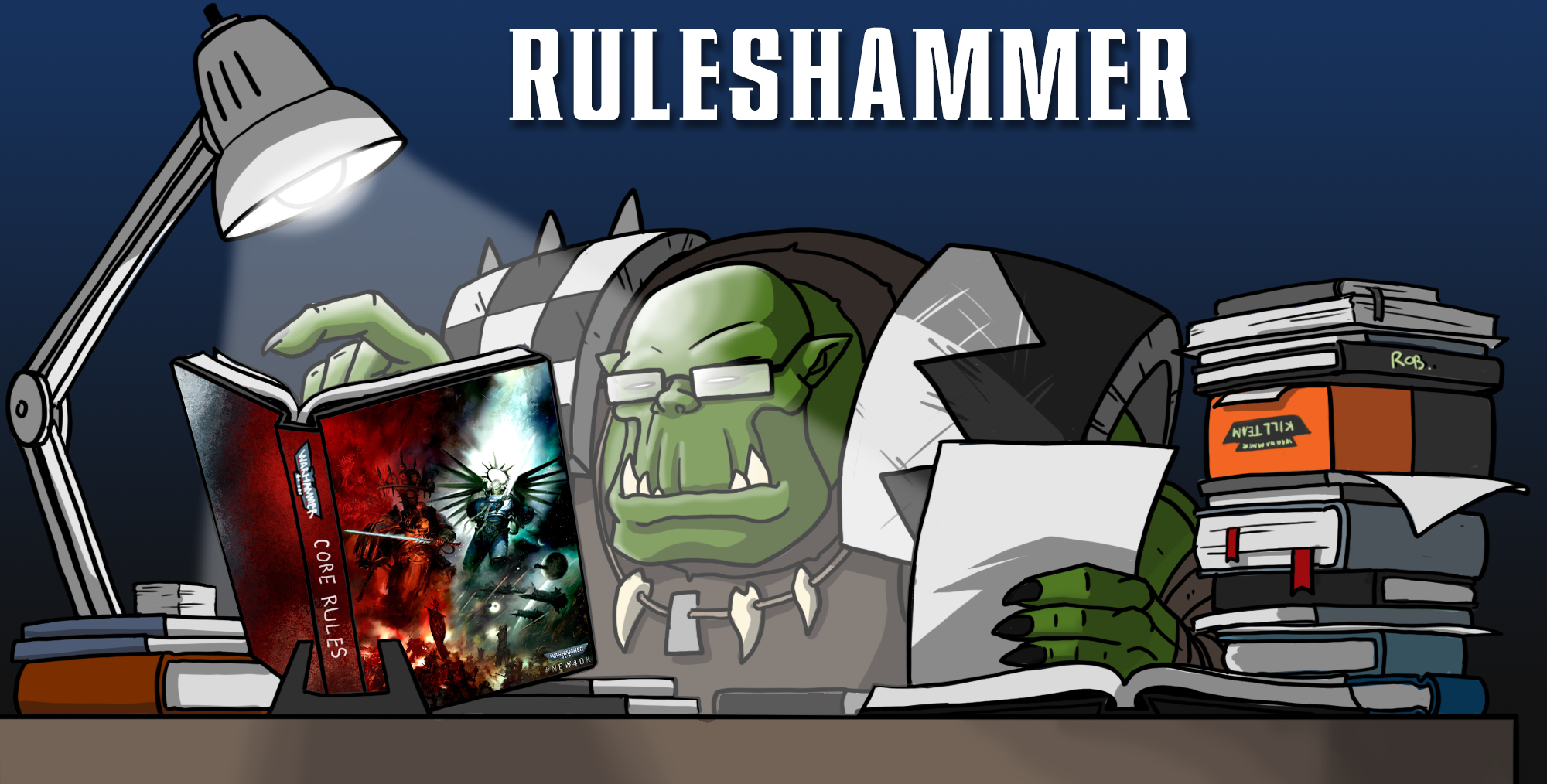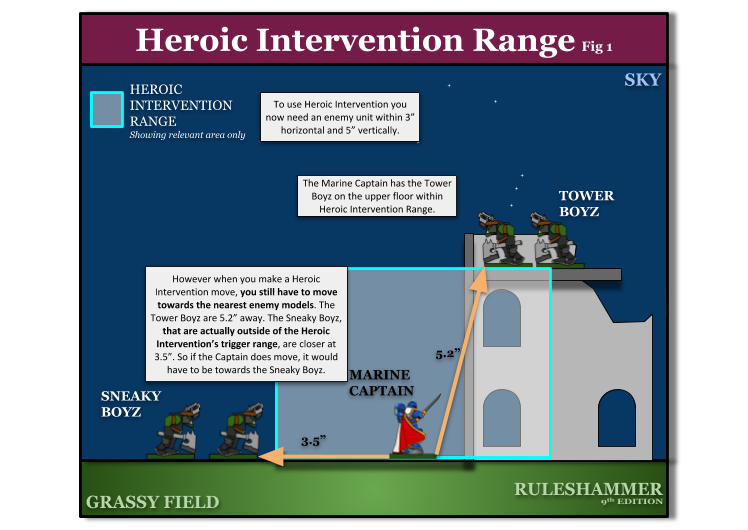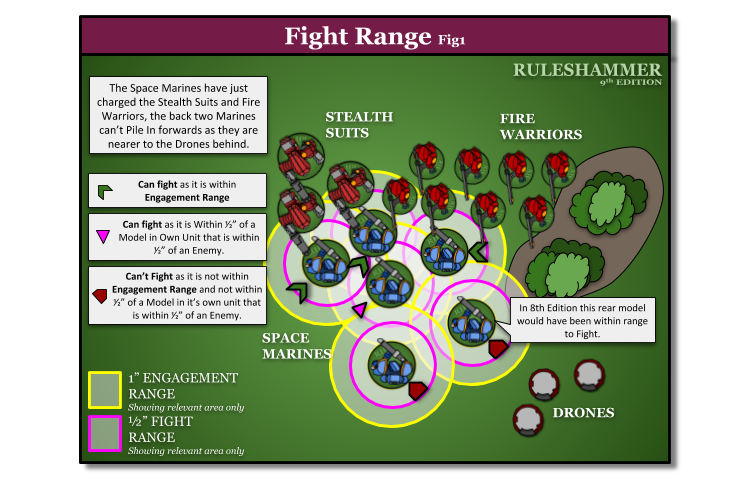With the new edition nearly upon us, Rob “Vre’kais” Chilton and James “One_Wing” Grover are continuing their tour through the updates. Ruleshammer will be doing daily posts over the next two weeks talking about key changes to the rules and going over each phase of the game. Today Wings dons the mighty wig of Judge Ruleshammer to talk about the Charge and Fight phases, with Rob illustrating with the diagrams you know and love.
The rules for the charge and fight phases in 8th Edition had a huge amount of depth to them, and used properly could allow an experienced player to run rings around their opponent. A lot of these interactions were at least somewhat counterintuitive, and pretty difficult to counter simply because of how permissive they were to a player who knew what they were doing.
9th makes some substantial changes here, generally tightening things up considerably so that the rules play more closely to how you’d instinctively expect, and there are more options for a player on the defensive to protect themselves. People deep into the competitive game in particular need to have a good read of this one – this is where some of the big shake-ups of tournament play are going to come from
The Charge Phase
Making Charges
This is a massive change right from the start. In 8th Edition, succeeding on charges was pretty easy – as long as you could connect with at least one of your charge targets with the first model you moved, you succeeded, and could often then use pile-ins to reach a bit further to get into some of your other targets. That meant that you’d routinely see units that could ignore overwatch declare charges against “everything in range” then worry about how they actually moved once they’d rolled their dice.
This has changed substantially. To make a successful charge, you have to meet the following criteria once your charge move is completed:
To make a charge move, the unit’s charge roll must be sufficient that it is able to end that move in unit coherency and within Engagement Range of every unit that was a target of its charge, without moving within Engagement Range of any enemy units that were not a target of its charge. If this is possible, then the charge is successful and the models in the unit make a charge move so as to fulfil the above conditions. [Core PDF Pg19-20, Book Pg224]
In short, speculative multi-charges are dead – you now need to make sure that you’re only declaring on units that you can reach, and that your models have enough coverage to engage all of them.
This especially weakens smaller combat units with the ability to fight multiple times, as you can’t charge into one thing, wipe it and then consolidate into another of your targets. It also has implications for flying units we’ll look at separately.
Heroic Interventions
Vertical Range
Similar to coherency and engagement, Heroic Interventions get a 5” vertical distance added to their trigger range, so that you can heroic if an enemy tries to hide on the second floor. Because you still have to end the move closer to the nearest model, this can cause some slightly odd effects – an enemy 2.9” to your left and 4.9” up is going to be further away than a model 3.5” to your right on the same level, so the presence of the first once can allow you to heroic into engagement of the second.
Realistically this will almost never come up, but it’s worth being aware of.
No Heroic for Units in Engagement Range
In 8th edition, you could heroically intervene with a character even if you were already within engagement range, often used to touch a charging unit’s base to try and shut down pile in tricks. That’s no longer the case – being within engagement range stops a CHARACTER being eligible to perform a heroic intervention. This makes it harder to use characters to stop pile in nonsense.
Overwatch
As previewed by GW, Overwatch is no longer “free” – in order to fire it, you need to either use the core Fire Overwatch stratagem, or have an ability that lets you do so. This forces the defender to consider the likely rewards of investing in the stratagem, rather than just throwing a bunch of dice for (often) little effect.
FLY in the Charge Phase
Fly works similarly in the Charge Phase as it does in the Movement phase, but with one main difference. Vertical movement is not ignored for moving over terrain like any other model. This was FAQed early on as well to make it clear than they can still jump over enemy units they haven’t declared as a charge target, despite moving within Engagement Range of them.
The Fight Phase
Who Can Fight Who
Vertical Engagement
The basic rules for which units can fight remain the same – you can choose units in engagement range and units that charged to fight. Remember, however, that engagement range now has a 5” vertical component as well, which can impact this.
Which Models Can Attack
This, on the other hand, gets a significant change. When fighting “through” another model in your unit, that model has to be within ½” of an inch of the target and you need to be within ½” of the model, rather than 1” in both cases.
This makes it substantially more challenging for hordes to line up weight of attacks, and makes it a bit harder for large-based units like Skyweavers to cover lots of ground while still attacking at full strength.
Targets for Chargers
Charging units are still limited in who they can attack, but as well as targeting the units they charged, they have gained the ability to attack any enemy unit that performed a Heroic Intervention. That stops intervening being as safe if it otherwise would be with it being riskier to multicharge – there’s still a risk/reward analysis to be made before tapping in.
Fight Ordering
As a reversal from 8th Edition, once all charging units and units with “fight first” abilities are done attacking, the non-active player selects the first “regular” unit to fight. This makes “fight first” effects a little bit more valuable, as they are less completely dead when you’re the one who wants lots of fights going off, and also make it safer to stay in an ongoing combat you think you can win in your turn.
Note: Fight First abilities have a special mention in the Appendix for 9th, the basic explanation is that you alternate between units that Charged and Fight First but even though the charge phase now starts with the “players who’s turn it’s not”, the “player who’s turn it is” chooses first activation from this group. I’ll cover this in more detail when we look at the Rare Rules Appendix next week.
Pile in and Consolidate
This is more of a rules hygiene thing than an actual change, but when the pile-in/consolidate step occurs, models already based by the enemy (so unable to move closer) still count as having piled in or consolidated.
A model that is already touching an enemy model cannot move, but still counts as having piled in. [Core PDF Pg21, Book Pg229]
This shuts down arguments about whether abilities that trigger after a unit consolidates (e.g. Syll’Esske’s double fight) refer to the step or the actual act of moving.
Attack Resolution
Attack resolution follows the same rules as the shooting phase – once you’ve chosen all your targets, you have to go through resolving all the attacks against each unit in turn, and all attacks with identical profiles in batches.
Basic Close Combat Weapons are No Longer Optional
In 8th, every model counted as being equipped with a basic S-user AP0 close combat weapon in addition to their other weapons. That was clearly intended to cover units with no listed weapon, but it often got used to make it easier for deadly attackers to wrap and trap things by reducing the chance of eviscerating their target with, say, a massive rocksaw.
This option is now only available to you if a model has no other weapons available, or cannot attack with any of them for some reason (e.g. Daemon weapons on a roll of 1). Models are also not “equipped” with this weapon, they just make attacks with one when the situation demands, which tidies up some issues where abilities on Forge World units cared how many weapons you were equipped with.
This definitely hurts armies that want to trap enemies, but it also feels more sensible – units choosing not to use their best weapons never made much sense narratively.
Fight and Charge Phase Conclusions
Taken together, these changes represent a huge shakeup – how close combat plays out in 9th is going to feel very different to some people. Hopefully the tradeoff for that is that there’s going to be a lot less time wasted with rulebooks proving that yes, no really, you can do that even if it seems improbable.
Have any questions or feedback? Got a rules question you want answered? Drop us a note in the comments below, ask a question in our Ruleshammer form, or head over to r/ruleshammer to discuss.





